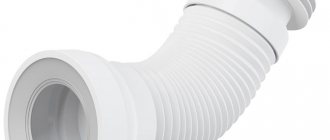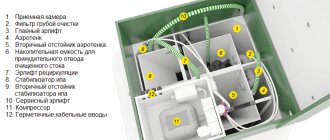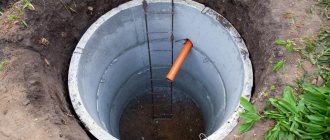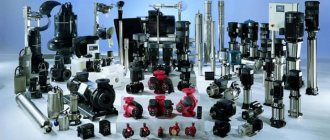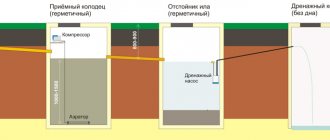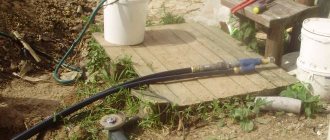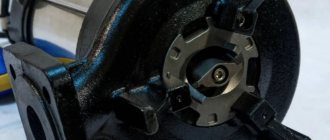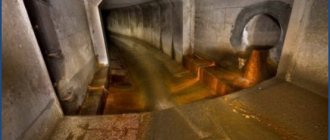A dry toilet is a device for the installation of which you do not need to build a cleaning system or lay a pipeline. In addition to independence from the central sewerage system, the list of advantages includes an increased level of comfort, ease of use, hygiene and compactness.
Dry toilets are especially popular among country property owners.
Existing types of dry toilets
A classic dry toilet is a sanitary design based on the natural decomposition of waste. The process is accelerated through the use of biological, natural components. There is also artificial drying and ventilation, which is implemented using electrical appliances.
It is compact and does not contradict all sanitary standards. The main advantage is that you can use this plumbing fixture anywhere because... there is no need to connect it to the sewer.
The dry closet is also convenient because it does not emit an unpleasant odor. Eliminating it is inherent in the operating principle of the device from the very beginning.
To process waste in dry closets, chemical solutions and natural mixtures are used, based on the following products:
- Peat. This component absorbs all liquid and processes waste products through mineralization.
- Compost. It works in a dry closet tank as well as in a compost pit.
- Sawdust. They are practically never used in their pure form. If they are used, it is only in combination with peat.
- Powder mixtures. These are loose, fine-grained preparations that absorb liquid well and provoke the process of complete waste recycling. They are produced specifically for dry closets.
- Microflora. It is a liquid containing bacteria that utilize waste.
- Bioenzymes. Liquids, the basis of which is a mixture of enzyme proteins and bacteria that decompose organic waste.
Dry toilets vary in design, but they have one thing in common - two containers. One of them is a toilet, and the second collects waste and processes it here. Knowing how to use a home dry toilet, you can significantly improve the quality of your stay both in a house outside the city and in a city apartment.
There are two large groups of these devices: mobile and stationary . The first is a design with small dimensions. There are no difficulties with it either during transportation or installation. With such a device you can go to the dacha, on a picnic, or on a long car trip.
The second group is bio-toilets-cabins. They are equipped with a replaceable container. When it is full, it is replaced with another.
Toilet cabins, made of high-quality materials, are quite comfortable. The main thing is to carry out maintenance and replenish consumables in a timely manner.
Visually, all models are ordinary toilets, but their operating principles are different.
On this basis they are divided into two types:
- Composting. These include peat and liquid-free models. In the first case, the liquid is not removed, but participates in the processing process. The second type includes all electric autonomous toilets, in which waste is processed into compost as a result of removing liquid from the mass, drying and pressing.
- Liquid. They are chemical and biological. The first storage containers are filled with a product based on formaldehyde, so the result of processing cannot be used as compost. A substance containing bacteria and bioenzymes is poured into the tanks of biological models. What is formed in the tank after their work goes into compost.
When choosing a dry toilet, they are guided by the appropriate processing method, the possibility of recycling or accumulating waste, the type of liquid or mixture, model and cost.
Comfortable life outside the city and its arrangement
Have you ever thought about what state the Earth will remain in for future generations? This question is by no means idle. After all, all the wastewater that enters the soil causes irreparable harm to nature. It was this problem that prompted the owners of country houses to arrange their own lives using such modern equipment as:
- Dry toilets;
- Septic tanks;
- Pumps.
We will tell you about each of these devices that allow you to create comfortable living conditions on the pages of this site.
Country cottages and country houses need to be equipped with sanitary rooms. And an indispensable attribute of such a room is plumbing. However, it is not always possible to use a regular toilet, and in this case a dry closet may be an ideal option.
They are produced in different types:
- Peat;
- Chemical.
A modern metropolis occupies a vast territory and its residents do not always manage to organize their lives in such a way that everything is within walking distance. The need to move from one area of the city to another often forces you to use a public toilet. Today they are used as toilet stalls. Although they find application outside the city with no less success:
- In villages;
- At the dachas.
The convenience of such equipment is undeniable. It helps to avoid eternal unpleasant odors, allows you to maintain cleanliness in the city and is indispensable during various cultural and social events.
Peat toilet specifics
A dry toilet of this type is also called peat or Finnish. If you choose a plumbing device based on its operating principle, this dry toilet is the simplest. It fully corresponds to the name “dry toilet”, because... Only natural ingredients are involved in waste processing.
As a drawback of the dry closet, we can note the specific “aroma” of the filler. For this reason, it is better to place it in an isolated room or outdoors
With this method of disposal, liquid is not needed. Waste is adsorbed by peat.
Features of the device and installation
In some cases, the Finnish dry closet is supplemented with an exhaust pipe, which is led out into a special hole or through a window. It should occupy a vertical position, height - at least 2 m. If there is a cesspool or compost pit nearby, you can build a hose into the lower part to remove liquid waste.
Place the hose in a trench no less than 1.5 m deep, which will protect against freezing of the liquid in winter. This improvement will reduce filler consumption and increase the intervals between removal of contents.
How to operate a peat dry closet?
The operation of a composting toilet is based on the division of waste accumulating in the tank into separate components: solid, liquid and their further breakdown. Outwardly, it resembles a classic toilet, but instead of water in the tank there is peat or other adsorbent. After each use, the filler must be added.
To allow peat to flow into the dry closet container, a dispenser handle is included in the design. After turning it two or three times, the entire contents are covered with peat. This creates a favorable environment for the life of microorganisms that convert waste into useful compost.
The waste powder tank, located in the usual place for the flush tank, is not provided in all models. If you purchased a model without it, you will have to carry out the procedure yourself using a scoop. In this case, the container with peat or sawdust is located separately
There are designs with an electric dispenser. Then a prerequisite is its connection to the electrical network. The required amount of peat per 10 liters of waste is only 1 kg. To increase its moisture absorption capacity, peat is sometimes combined with sawdust.
The contents of the dry closet will turn into compost, which can be used to fertilize the garden, in two years, and until that time it is kept in a compost pit.
You can read more about how to clean dry closets in this material.
How to use it correctly
To prevent unwanted load on the tank and pressure surges, before each use you need to remove the top cover of the storage tank and then put it back in place. It should be remembered that when transporting the dry closet to places with high atmospheric pressure, you should keep the lid of the storage tank open. To complete the preliminary installation of a dry toilet, it is worth filling the toilet with water using a pump or using a lever that acts on the valve. The contents in the toilet are flushed when you press the lever, which is powered by electricity.
You can learn how to make a country shed with a toilet and shower from this article.
What toilets and showers look like for a summer residence is indicated in this article.
How to build a country toilet with your own hands can be seen in this article here:
The best models of peat dry toilets
High quality, aesthetics, versatility and mobility, comfort and aesthetics - this is how most models of peat dry closets can be characterized.
Among them:
- Tandem Compact-M;
- Tandem Compact-Eco;
- Compact Lux M;
- Piteco 506;
- Piteco 905;
- Bioecology Ecolight Summer Resident;
- Kekkila Ecomatic Green.
These are mainly stationary structures. They are compact, made of different materials, and have a different set of components.
#1: Model “Tandem Compact-M”
This model is a stationary design with a 60 liter storage tank. The dimensions of the device are 420 x 580 x 720 mm. The seat is at a height of 380 mm. The weight of this dry closet is 5 kg.
For normal operation, a drainage system and ventilation are required. For the latter, a ventilation pipe with a cross section of 10 cm is used.
LLC "Tandem" The material of its body is low-pressure polyethylene (HDPE), the upper part is polystyrene. It does not have a detachable waste container. It is replaced by the base of the toilet
The tank is large enough that waste can be cleaned once a month. It can be installed in a house or in a non-residential extension. There are special handles on the body for moving.
#2: Characteristics of “Tandem Compact-Eco”
This model is the same stationary dry flush toilet, but with a slightly larger storage tank - 70 liters. The polyethylene body design can withstand a maximum load of 180 kg. The height of its seat is 450 mm, dimensions are 520 x 710 x 720 mm.
The Compact-Eco body is made of polystyrene, which is impact-resistant. The design consists of two parts: a cover and a base. At the back there is a tank with peat and a lever for dry flushing. A seal is placed between the base and the lid
A storage container with a separator is placed inside the base. Both of these parts are made of flexible plastic. A separator separates liquid waste from solid waste. To do this, it has special holes at the bottom and bottom through which liquid leaves and enters the storage part of the structure. The solid part of the waste remains in the separator.
#3: Dry toilet Piteco 506
The design is characterized by small dimensions - 390 x 590 x 710 mm, weighs 20 kg. The seat is at a height of 420 mm. The upper tank has a volume of 11 liters, the storage tank is four times larger - 44 liters. The maximum permissible load is 150 kg.
The Piteco 506 body is made of PP. Equipped with a direct-flow ventilation pipe. The container in which the waste comes has three convenient handles
The pipe included in the kit is 3 m long. In addition, the kit contains 3 couplings, a two-meter drainage hose with a clamp and a seat with a lid.
#4: Dry toilet Piteco 905
This dry closet is the most spacious in its line. With rather modest dimensions - 59.5 x 82 x 80 cm, the storage tank holds 120 liters, the upper tank - 30 liters. Toilet height 48 cm, weight - 12 kg.
The volumetric tank has wheels. In combination with recessed handles on the walls, this ensures convenient transportation. The maximum load is 150 kg
The tank is connected to the drain via a fixed base platform. The outlet after disconnection is closed hermetically by an automatic valve. During waste removal, the ventilation pipe is disconnected from the housing.
#5: Toilet Bioecology Ecolight Summer Resident
Ecolight toilets are produced. This is a stationary cabin equipped with a storage tank holding 225 liters. Design dimensions: 1.15 x 2.3 x 1.15 m, weight 60 kg.
The Ecolight Summer Resident dry closet cabin consists of four profiled enclosing side structures, a translucent roof, and a door with a latch. Reinforced tray included
The toilet cabin is made of polyethylene - impact-resistant and fireproof. The set is complemented by an exhaust pipe and a comfortable seat with a lid. There is a special holder for bags inside the cabin.
Unpleasant odors and harmful fumes are neutralized by the ventilation system. Installation and dismantling of the structure is easy, and for its operation there is no need for sewerage, water supply or power supply.
What is a chemical toilet?
This formulation corresponds to a portable outdoor cabin, an indoor mobile toilet, and a block consisting of several cabins where waste is accumulated in receiving tanks. The role of “orderlies” here is played by chemical concentrates based on formaldehyde.
They neutralize odors, prevent the proliferation of various fungi and microbes, and dilute waste. For this reason, the prefix “bio” does not sound entirely correct here.
Considering the features of such a dry closet and how it works, we can come to the conclusion that the waste processed in it cannot be called environmentally friendly. Therefore, composting and using them is not recommended.
Cost-effectiveness is their main advantage - only 5 ml of “chemistry” is needed for 1 liter of waste. Structurally, these are two containers in contact with each other. The top tank contains water. It is necessary for rinsing. The lower tank is designed for waste recycling.
Odors and liquids do not escape due to the presence of a sealing valve. More advanced models have an indicator. It gives a signal as soon as the tank is full.
After filling the bottom tank of a portable chemical toilet, it is disconnected and all the contents are poured out of it. There is a special place for this.
Thus, a container with a volume of just over 20 liters must be emptied once every seven days, provided that the toilet is used by a family of three people. This option is very convenient when there is a bedridden patient in the family.
In this case, a toilet of this design can be placed under the bed. At the same time, as the manufacturers assure, there will be no unpleasant odors in the apartment.
Maintenance of a country toilet in winter and preservation of the sewage system in the country
If there is a toilet installed in the toilet stall at the dacha, then in very severe frosts the siphon may freeze.
If the summer season ends in the fall, then to prevent the toilet siphon from freezing, it is necessary to completely drain the water from it when leaving. This can be done using soft paper that absorbs moisture well, but even with prolonged and careful scooping, a small amount of water may still remain in the siphon. Because of this, in severe frosts the siphon in the toilet in the country may even burst. To prevent this from happening, it is recommended to use regular table salt. It will prevent such an unpleasant phenomenon, since salt water freezes at a lower temperature. In addition, you can pour 0.5-0.7 liters of non-freezing liquid, such as antifreeze or antifreeze, into the drain hole in the country toilet for the winter.
To maintain the sewage system at your dacha in normal condition in winter, it is recommended to drain the water from the drain tank so that the system is completely dehydrated.
All drain valves and plugs must be open, because some water will remain in the pipes in any case. When the temperature drops to negative values, the freezing process will force it out of the open taps. Then there will be no problems with freezing water later.
If the drain valves and plugs are closed, then when the container or pipe freezes, they may simply burst.
Before preserving the sewer system for the winter, all taps and valves at the inlet must be lubricated with machine oil, and then shut off and wrapped with plastic film.
To ensure uninterrupted operation of the sewage system, it must be carefully prepared for winter. To do this, you should check and clean all constructed sewer pipelines in advance.
With the onset of frost, this work will be much more difficult. In addition, the sewage system must be well insulated to protect against freezing. Otherwise, it may be disabled for a long time.
It is necessary to carry out an annual autumn inspection and cleaning of pipelines in places where they may become clogged. Such problem areas are mainly areas of branches and joints.
If the sewer system is equipped with a septic tank, it is recommended to clean the storage tank. Carrying out cleaning work of the sewerage system in the fall makes it possible to avoid unpleasant emergency situations.
Popular models of chemical toilets
Among the most popular chemical dry toilets are the following models:
- Thetford Porta Potti Qube 365;
- Enviro 20;
- Mr. Little Ideal 24;
- Ecostyle Ecogr;
- Bioforce Compact WC 12-20VD.
There are no global design differences between different models. The difference is in the volume of the storage tank and the availability of additional options.
#1: Thetford Porta Potti Qube 365 composting toilet
This portable model is the most popular among chemical toilets. Consumers are attracted by the light weight (4 kg) and compactness (41.4 x 38.3 x 42.7 mm). In this case, the lower tank is designed for 21 liters, and the upper one for 15 liters. The distance from the bottom to the seat is 40.8 cm. According to its parameters, this is the best option when caring for a disabled person.
Flushing with water in this dry closet is carried out using a piston pump. Without emptying, the reservoir will last approximately 50 cycles of use. Three people can use it for about a week
An indicator will indicate the need for maintenance. The lower tank is removable and has handles for carrying.
The negative point is the considerable cost of the drug that breaks down waste.
#2: Enviro 20 chemical toilet
The model is an economical option. It is produced in Canada and can be a good solution for traveling and caring for the disabled. The volume of the upper container is 10 l, the lower one is 20 l. Using latches, the tanks are fixed motionless in relation to each other.
The dry closet is easy to clean using a hand pump. The body is made from frost-resistant material (polystyrene) and is complemented with a corrosion-resistant coating. Drain valve prevents fluid leaks and unpleasant odors.
Structurally, the sanitary system is designed so that the storage tank is easily emptied. Filling the flush tank is also no problem. There is also a filling indicator.
#3: Toilet Mr. Little Ideal 24
"Mr. Little" is designed for a large family - 4 - 7 people. Its dimensions are 42 x 41 x37 cm. The reservoir holds 15 liters of water for flushing. The waste container can be filled up to a volume of 24 liters. There are indicators on the receiving tank and water tank.
A piston pump is built into the flushing system. The sanitary device operates in a temperature range from +1 to + 40 degrees.
“Mr. Little” weighs 4.6 kg. At the same time, it can withstand loads of up to 250 kg on the body and 30 kg on the lid. Withstands external temperatures from – to + 40⁰
A special liquid is poured into the reservoir, which is located below. Waste breakdown continues for 10 days. A special handle on the storage tank, as well as a built-in removable pipe, simplify the disposal process. In addition, there is an air bleed valve on the housing.
Hidden guides and additional fasteners give this model additional stability. The plastic from which the structure is made does not absorb odors.
#4: Model Ecostyle Ecogr
Chemical toilet Ecostyle Ecogr is a UV-resistant polyethylene toilet cabin. The kit includes a front panel - a door and an arch made of a steel frame. The structure is secured with high-strength hinges on steel rivets. Inside there is a latch equipped with a busy indicator and a hook for things.
The roof and side panels of this model have a modern design. The design looks aesthetically pleasing both in a summer cottage and in other areas
This dry closet weighs 80 kg. The receiving tank is spacious - 250 l. In the cabin there is a wooden pallet impregnated with a moisture-repellent substance. Cabin dimensions - 1.1 x 2.2 x 1.1 m.
#5: Portable model Bioforce Compact WC 12-20VD
The design is assembled from two compartments: upper - 12 l and lower - 20 l. The first is filled with the flushing inlet. It is complemented by a pump and a seat with a lid. The lower compartment collects waste.
There is a sliding valve that does not allow odors and liquids to pass through. Excess pressure is released via a release valve. The waste level is monitored by an indicator.
The model is designed for a maximum load of 120 kg. It has dimensions of 370 x 435 x 420 mm. The lower tank is removable
These chemical toilets are produced in Thailand. Their installation does not require additional ventilation or communications.
Features of an electric dry closet
This design is significantly different from the first two. The liquid from the electric toilet is discharged into a cesspool or into the sewer. Solid residues are sprinkled with disinfectant powder and dried or burned.
In any case, waste takes up a very small volume. They can then be used as fertilizer. Among autonomous toilets, this design is the most expensive and requires constant power supply and forced ventilation.
Without this, it will not be possible to avoid the odors that appear when burning or drying solid residues. Therefore, ventilation is a must.
#1: Electric dry closet Cinderella
The plumbing fixture is produced in Norway. It is considered waste-free. There is no need to connect water to it. The flushing process is carried out using a compressor connected to the mains.
For the normal functioning of an electric dry closet, neither biological nor chemical agents are needed. After the recycling procedure, the output is an environmentally friendly mass
Waste incineration is carried out in a special container. After this, only 100% safe ash remains, from which the toilet is emptied twice a month. This dry closet operates from a 220 V network. Ventilation is installed through the roof or through the wall.
#2: Electric dry toilet Separett Villa 9011
This electric dry closet was produced in Sweden. Its distinctive feature is that it can even be connected to a car battery. The model operates without water connection. The liquid component of the waste leaves through a flexible hose, and the solid component in a 23-liter tank is dried and reduced in volume by up to 70%.
The Separett Villa 9011 case is made of impact-resistant material, so it is resistant to abrasions and scratches. The plumbing fixture is equipped with a comfortable polypropylene seat. The kit includes all parts for installation
For the fan to work, it is connected to a voltage of 220 V. The kit also includes a seat for children. The only negative is the mandatory ventilation device.
For some, the inconvenience is the fact that the device can only be used in a sitting position. This is explained by the fact that the back of the container in which waste is collected opens only under the weight of a person.
#3: BioLet 25 dry toilet
This stationary electric toilet with an ABS plastic body is made in Sweden and is designed for 3 people. Equipped with a fan and automatic compost mixing function. Dimensions of the plumbing fixture - 550 x 650 x 710 mm. Height from base to seat - 508 mm.
The power consumption of the plumbing system is 20 - 5 W. The kit includes the toilet itself, pipes, and a catalyst. An exhaust system is required for proper operation.
Inside the structure, all biomass must be in a homogeneous state. To achieve this, the compost and waste are mixed regularly by automatically turning on the mixer. Switching on occurs when the lid is raised and lowered. At the same time, oxygen enters
During mixing, some of the dry processed product spills into the tray through the grate. The compost mass is blown by a fan. Vapors and odors escape through the ventilation system. If liquid accumulates above normal, the float switch automatically activates the air blower.
The thermostat can also be used to manually adjust the liquid level by adding or lowering degrees inside.
Recommendations for future dry toilet buyers
When choosing a suitable dry closet, you should be guided by several criteria:
- Simplicity of design and convenient operation.
- Hygiene, ability to retain unpleasant odors.
- Stability, strength, high-quality assembly.
- Ease of maintenance.
- Volume of the tank. It must correspond to the number of residents.
- Seat height. The optimal size is 400–460 mm, but the presence of children must also be taken into account.
- The presence of a seat heating function and a tank full indicator.
For use in a country house, it is advisable to purchase a portable plumbing system. In summer she can be outside, in winter - in the house.
It is better if the selected dry toilet does not use chemicals. Then the processed waste can be used as fertilizer.
If the model is electric, then where it is to be used there should be no problems with power supply.
Both in a country house and in urban housing, a bio-toilet bowl should be comfortable and convenient. They buy it for a long period, so the plumbing fixtures must be of high quality and durable
For an apartment, a stationary option with a good design is better. If finances allow, you can install an electric model with many functions. You also need to calculate the volume of the container; the frequency of its emptying depends on this.
If you don’t have enough money to buy a dry closet, you can build it yourself. You can read how to do this in this material.
Guarantee
Manufacturers provide warranty periods of 2 to 3 years for various models. Servicing is carried out only on models with a manufacturing defect that was discovered immediately after purchase, or after some time during operation within the period specified by the manufacturer.
If the product turns out to be faulty after examination, it will be replaced with a new one in accordance with the Law on Consumer Rights. The product kit includes spare parts; they also have a warranty period, but much shorter. The period is one year from the date of purchase of the main product.
The moment of acquisition is considered to be the day the purchase was made using a cash register or sales receipt.
List of claims by category that will be denied replacement or repair:
- failure to comply with the operating rules specified in the instructions for use;
- incorrect installation of equipment;
- application of modifications;
- the initial repair was not carried out by a certified maintenance service;
- detection of counterfeit codes or product serial number;
- removing a code or serial number;
- damage due to improper use.

